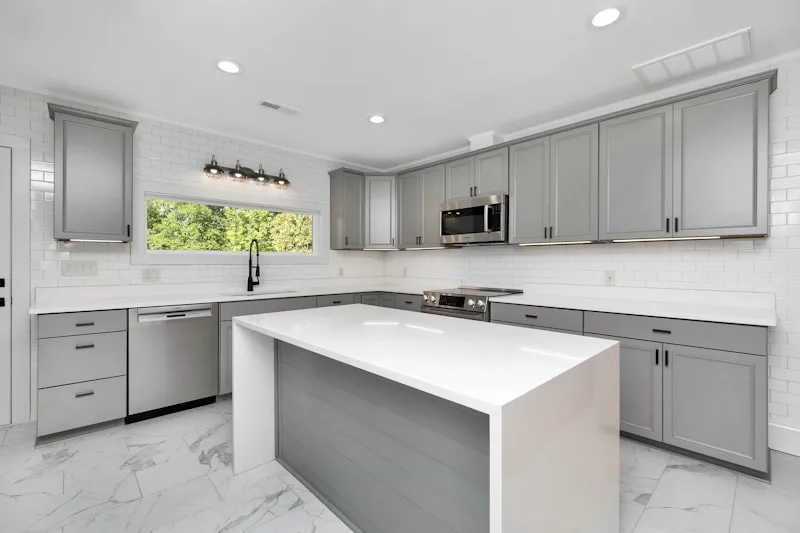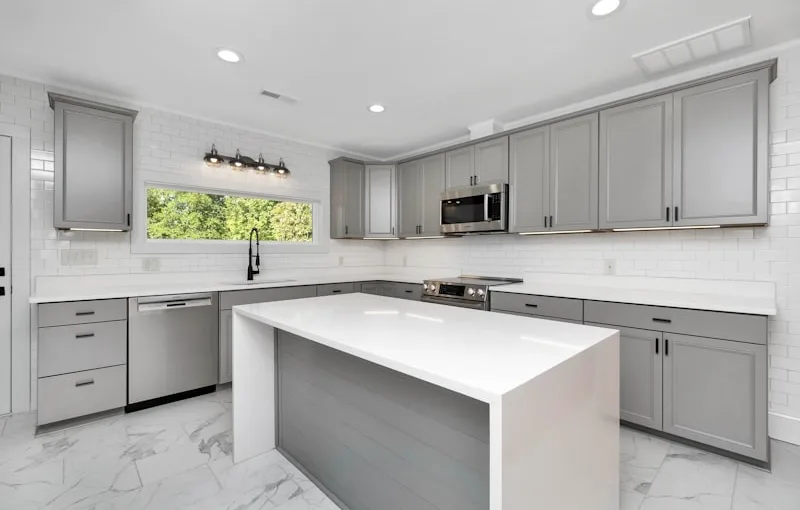Typically, standard kitchen cabinets stand around 34.5 inches tall. This height is designed to be comfortable for most people, allowing easy access to pots, pans, and all those kitchen gadgets we can’t live without. But here’s the kicker: not all kitchens are created equal! If you’re on the taller side, you might find yourself bending down a bit too much, while shorter folks might feel like they need a step stool just to grab a bowl.
Now, let’s talk about the upper cabinets. These usually hover around 18 inches above the countertop, but that can vary based on your ceiling height and personal preference. Some homeowners opt for a higher placement to create a more open feel, while others prefer them lower for easy access. It’s like finding the perfect pair of shoes—comfort and style need to go hand in hand!
And don’t forget about custom cabinets! If you’re feeling adventurous, you can design cabinets that fit your unique height and style. Think of it as tailoring a suit; it’s all about making it fit you perfectly. So, whether you’re a DIY enthusiast or working with a designer, the height of your kitchen cabinets can be a reflection of your personality and lifestyle.
In the end, the right height can transform your kitchen into a functional and stylish space, making every meal prep feel like a walk in the park.
Reaching New Heights: The Ultimate Guide to Kitchen Cabinet Dimensions
First off, standard base cabinets usually stand about 34.5 inches tall, which is perfect for most countertops that sit at 36 inches. This height is like the sweet spot for cooking and prepping meals without straining your back. But what if you’re on the taller side? You might want to consider cabinets that are a bit taller, giving you that extra comfort while whipping up your favorite dish.
Now, let’s talk width. Base cabinets typically come in 3-inch increments, ranging from 12 to 48 inches. Think of it like building blocks; you can mix and match to create a layout that fits your kitchen’s unique shape. Want to add a spice rack or a pull-out trash bin? Custom widths can make that happen, turning your kitchen into a functional masterpiece.
And don’t forget about depth! Standard base cabinets are usually 24 inches deep, but if you’re looking for a sleek, modern vibe, you might opt for shallower cabinets. It’s like choosing between a cozy blanket and a sleek throw—both have their charm, but it depends on your style.
Cabinet Heights Unveiled: Finding the Perfect Fit for Your Kitchen
First off, think about your own height and reach. If you’re on the shorter side, towering cabinets might feel like a mountain you can’t climb. On the flip side, if you’re tall, low cabinets can feel like they’re squatting in your space. A standard cabinet height is usually around 30 inches for base cabinets and 36 inches for wall cabinets, but that’s just the starting point. Customizing your cabinet heights can transform your kitchen into a space that feels uniquely yours.
Now, let’s talk about the ceiling. If you have high ceilings, why not take advantage of that vertical space? Installing taller cabinets can draw the eye upward, creating an illusion of grandeur. Think of it like wearing a pair of high heels; they elevate your look and give you that extra boost of confidence. On the other hand, if your kitchen has lower ceilings, opting for shorter cabinets can help maintain a cozy, inviting atmosphere.
From Floor to Ceiling: How Kitchen Cabinet Height Affects Your Space
So, how does cabinet height really affect your kitchen? First off, taller cabinets can give the illusion of higher ceilings, making your space feel more open and airy. If you’ve got a smaller kitchen, this can be a game-changer. It’s like adding a vertical garden to a tiny apartment; it draws the eye upward and creates a sense of depth. Plus, those extra inches mean more storage for all your pots, pans, and gadgets. Who doesn’t want a little more room to stash their kitchen treasures?
On the flip side, if you’re on the shorter side or have kids running around, lower cabinets might be more practical. Think about it: you don’t want to be climbing on a stool just to grab a spice jar. It’s all about balance. You want your kitchen to be functional and stylish, right?
The Science of Kitchen Cabinet Heights: What You Need to Know
First off, the standard height for upper cabinets is typically around 18 inches above the countertop. This height strikes a balance, allowing you to work comfortably without feeling like you’re in a game of limbo every time you chop veggies. But here’s where it gets interesting: everyone’s body is different! If you’re on the taller side, you might want to consider raising those cabinets a bit higher. Conversely, if you’re more petite, lowering them could save you from a daily workout just to grab a mug.
Now, let’s talk about the ceiling. If you’ve got high ceilings, don’t just leave that space above your cabinets empty! You can install cabinets that reach all the way up, creating a seamless look and maximizing storage. Think of it as a vertical garden for your kitchen—more space means more room for your culinary treasures.
And what about the depth? Standard cabinets are usually 12 inches deep, but if you’re a passionate cook, you might want deeper cabinets to accommodate larger pots and pans. It’s like choosing between a cozy little nook and a spacious living room; it all depends on your lifestyle.

So, whether you’re a DIY enthusiast or working with a designer, understanding the science of kitchen cabinet heights can transform your cooking space into a functional masterpiece. After all, a well-designed kitchen is like a well-tuned instrument—everything just flows!
Frequently Asked Questions
Can I Customize the Height of My Kitchen Cabinets?
Yes, kitchen cabinets can be customized to different heights to suit your needs and preferences. This allows for better functionality and aesthetics in your kitchen space. Consult with a professional to determine the best height for your cabinets based on your kitchen layout and personal requirements.
What is the Standard Height for Kitchen Cabinets?
The standard height for kitchen cabinets is typically 34.5 inches for base cabinets and 30 inches for wall cabinets, measured from the floor to the top of the cabinet. This height allows for comfortable use and accessibility, accommodating standard countertop heights and providing adequate storage space.
What Factors Affect Kitchen Cabinet Height?
The height of kitchen cabinets is influenced by several factors including ceiling height, user ergonomics, cabinet design, and the intended use of the space. Standard cabinet heights typically range from 30 to 36 inches for base cabinets and 12 to 42 inches for wall cabinets. Customization may be necessary to accommodate specific user needs or to optimize storage and accessibility.
Are There Different Heights for Upper and Lower Kitchen Cabinets?
Kitchen cabinets come in various heights to accommodate different needs and preferences. Upper cabinets are typically installed higher to maximize wall space and provide easy access to frequently used items, while lower cabinets are designed for convenience and accessibility, often aligning with standard countertop heights. Customization options are available to ensure optimal functionality and aesthetics in your kitchen.
How to Choose the Right Height for My Kitchen Cabinets?
Selecting the appropriate height for kitchen cabinets is crucial for both functionality and aesthetics. Consider the height of the primary users, ensuring that the cabinets are accessible without straining. Standard upper cabinets are typically installed 18 inches above the countertop, but this can vary based on ceiling height and personal preference. For a cohesive look, align cabinet tops with the height of adjacent appliances or trim. Always measure and plan according to your kitchen layout to optimize space and usability.
